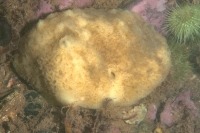
(Photo: Claire Goodwin)
Sheep's Tongue Sponge
Mycale lingua
Pale yellow sponge forming mounds of varying sizes. It has prominent, large (four to ten millimetre diameter) oscules (holes) in its surface. The sponge surface is covered in a distinctive pattern of long, narrow channels.
Authority
Bowerbank, 1866
Classification Details
Phylum: Porifera (sponges); Class: Demospongiae (siliceous sponges).
Habitat
Found growing on bedrock. Distributed over the North Atlantic from Spitzbergen to the Azores. In the northwestern Atlantic from the Gulf of St. Lawrence to Maine. This species is usually a deeper water species, only rarely found at SCUBA diving depths. Recorded from 30 to 3 460 metres over much of its range but in the Bay of Fundy it is found as shallow as seven metres.
Diet
Sponges feed on small particles in the seawater. 80% of their diet is bacteria-sized particles (<0.5 micrometres in diameter). They suck seawater into a network of canals in their body using a current generated by cells called choanocytes. The choanocytes also capture the food particles.
Reproduction
Hermaphrodite – individuals are both male and female. Sperm is released into the water column, then sucked up by another sponge and used to fertilize its eggs. The sponge then broods the resulting embryos in its body tissue until they develop into free-swimming larvae that are released into the seawater. After a few days in the seawater, the larvae settle and develop into adult sponges.
Fun Facts
The Latin name comes from lingua meaning tongue. The form of this species was thought to resemble a sheep's tongue.
References
Bowen S, Goodwin C, Kipling D, Picton B (2018) Sea squirts and sponges of Britain and Ireland. Plymouth: Wild Nature Press. Goodwin C (2017) Field guide to the sponges of the Bay of Fundy. Huntsman Marine Science Centre. Available from https://www.researchgate.net/publication/319433507_Field_Guide_to_Sponges_of_the_Bay_of_Fundy Van Soest RWM, Boury-Esnault N, Hooper JNA, Rützler K, de Voogd NJ, Alvarez B, Hajdu E, Pisera AB, Manconi R, Schönberg C, Klautau M, Kelly M, Vacelet J, Dohrmann M, Díaz M.-C, Cárdenas P, Carballo JL, Ríos P, Downey R and Morrow CC (2019) World Porifera Database. Mycale (Mycale) lingua (Bowerbank, 1866). http://www.marinespecies.org/porifera/porifera.php?p=taxdetails&id=168640 Accessed online 20 January 2020. Van Soest R, Picton B, Morrow C (2000) Mycale lingua - Sponges of the NE Atlantic. http://species-identification.org/species.php?species_group=sponges&id=331 Accessed online 20 January 2020.

